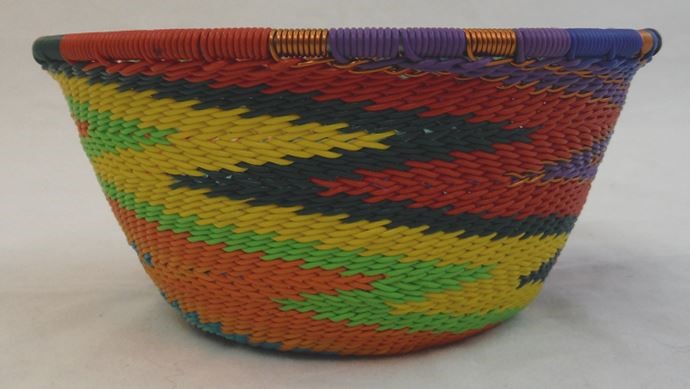Basketry has developed in all parts of the world, and the objects produced reflect their uses, their meanings, and the cultures that made them. Traditional cultures use basketry to make nets and weirs for hunting and fishing, to hold and distribute seeds during planting, to gather crops during the harvest, to process foods and materials, to store and ferment, and to hold, transport, and serve foods—as well as for making a diversity of other objects including musical instruments, costumes, and ritual objects. The skill and ability to produce basketry has therefore been essential to everyday life in traditional cultures.
Most of the baskets in this exhibit are made using traditional African basketry materials. The bodies of the baskets are woven using different types of palm fiber, which include the thin, round stems of palm known as rattan, the flat strips of the ilala palm leaf, and the softened palm leaf stalks that are known as raffia. Coiled baskets have coils composed of banana leaves, grasses, or reeds, and a piece of gourd forms the base of some baskets. The basket fibers are dyed different colors with natural vegetable and mineral pigments. Despite mastering all of these different natural materials, however, African weavers are also known for their creative experimentation with new materials and forms, as illustrated by the colorful, popular Zulu telephone wire basket.
As with the making of other textiles, basket making in Africa is often traditionally a woman’s craft, and African women have developed basketry of all kinds into a highly refined form of art. The baskets are skillfully woven–with some woven so tightly that they are used to hold liquids–and they take creative, sculptural forms that weavers continue to develop. Baskets are embellished with decoration that ranges from the simple to the elaborate, and often the designs have specific meanings or references. Today, basketry forms an important part of the African economy, with many weavers supporting their families and continuing to keep traditional forms and designs alive, as well as developing exciting new forms of basketry, in response to demand from the tourist trade.
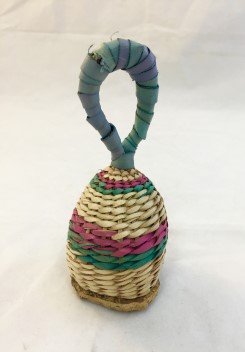
Bamana culture
21st century
Rattan, palm leaf, calabash, and pigments, L. 4.5 cm x W. 4.5 cm x H 12.5 cm
BFPC collection #2013.1a
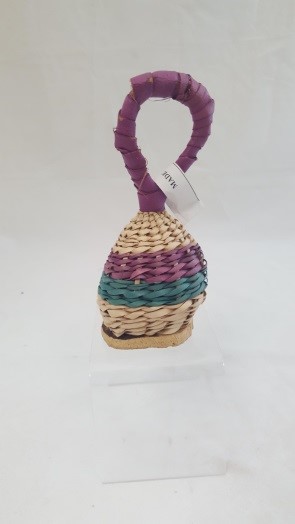
Bamana culture
21st century
Rattan, palm leaf, calabash, and pigments, L. 7 cm × W. 7 cm × H. 14.5 cm
BFPC collection #2013.1b
Often referred to simply as a shaker, the kese kese is a rattle woven onto a gourd base and then filled with seeds, pebbles, or even small pieces of metal such as bottle caps. Among the Bamana people of Mali, kese kese are used as percussion instruments by people of all ages, from children to adults; they are usually played in pairs to accompany singers and help them keep the beat of the music. Specialized hand positions and movements are used to make different sounds with the kese kese, as the contents of the rattle may be made to strike against different parts of the woven body or against the gourd base. Traditional Bamana kese kese have a more geometric, pyramid-shaped body; because these rattles are rounder, reflecting the shape and size of a European children’s rattle, they were most likely produced for the tourist trade. Nevertheless, the construction, the materials, and the sounds made by these instruments are authentic. Researched by Lindsay Werner and Caitlin Baker
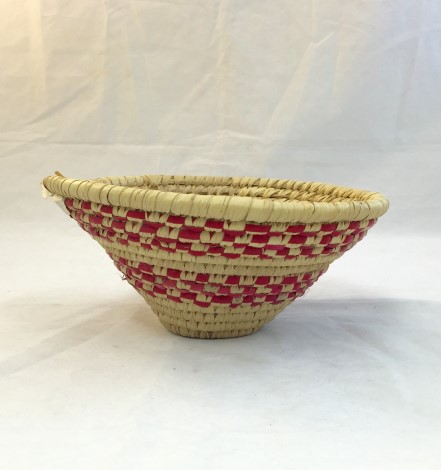
Iteso culture?
20th century
Raffia, banana leaf, and pigment, L. 18 cm x W. 18 cm x H. 9cm
BFPC collection #2011.42
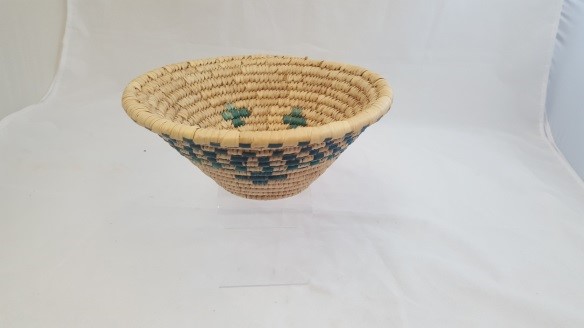
Zulu culture?
20th century
Raffia, banana leaf, and pigment, L. 15 cm × W. 15 cm × H. 9 cm
BFPC collection #2011.43
Basketry has become a very important source of income for the peoples of Uganda, and these baskets represent the products of cooperatives that were developed to allow people to continue their traditional arts while also making a living through selling to the tourist trade. These particular baskets illustrate the interaction of cultures and the creative sharing of ideas in Africa, as the shape of these baskets resemble traditional Zulu basketry covers for ceramic beer vessels, but the materials and designs resemble baskets from the Iteso culture. Female artisans make the baskets with raffia and banana leaf using the coil technique, which creates a sturdy basket that is meant to hold dry goods. Researched by Lindsay Werner and Caitlin Baker
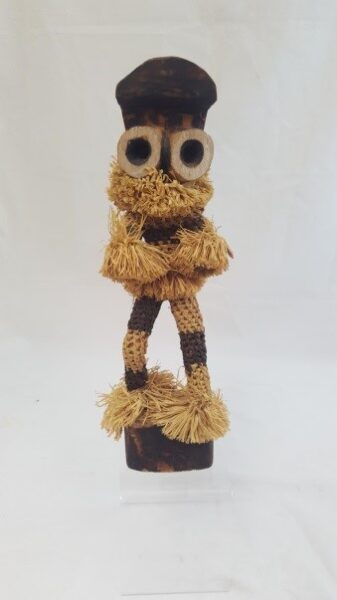
Pende culture
20th century
Wood, raffia, and pigment, L. 6 cm × W. 4.5 cm × H. 26.5 cm
BFPC collection #2009.12
This figure portrays a Minganji masquerader, a dancer who serves as a guardian of the Pende culture boys’ initiation camp. The boys spend several months in these camps, where they are circumcised and where they learn basic survival skills and the skills required to assume adult roles in the community.
The Minganji are believed to be dangerous supernaturals associated with sorcery; the Minganji masqueraders portray these supernaturals and act as police, both supervising and protecting the boys in the camps. Their basketry costumes consist of masks with protruding, cylindrical eyes and full-body garments made of netted raffia fiber. The strength of the raffia fiber allows the dancers to perform energetic dances, and the raffia ruffs around the neck, waist, wrists, and ankles emphasize the frantic movements of the dance. Researched by Caitlin Baker
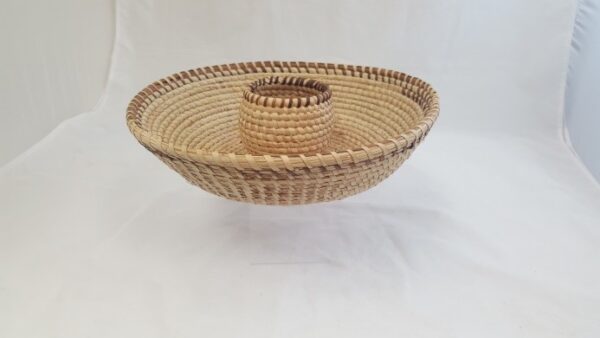
Ovambo culture?
20th century
Reed, palm leaf, and pigment, L. 26 cm × W. 26 cm × H. 7.5 cm
BFPC collection #2011.47
The style, shape, and materials of double-bowled basket suggests that it was made by the Ovambo culture of Namibia, who are known for making such simply designed, coiled serving baskets of reed and palm leaf. The double-bowl form of the basket, however, reveals that it was most likely made for the tourist trade, as this form is unknown in traditional African basketry. The form suggests that a small condiment bowl was meant to be placed in the central basket, and that this should serve as a “chip and dip” bowl. Researched by Caitlin Baker
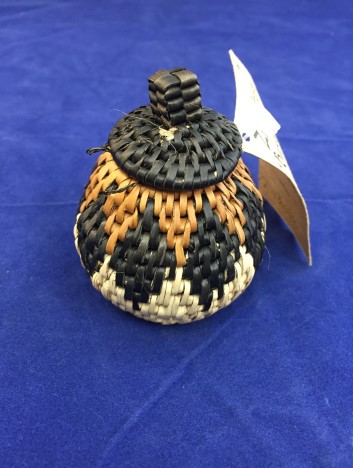
Zulu culture
20th century
Palm leaf, grasses, and pigment, L. 6 cm x W. 6.2 cm x H. 8 cm
BFPC collection #2013.31a
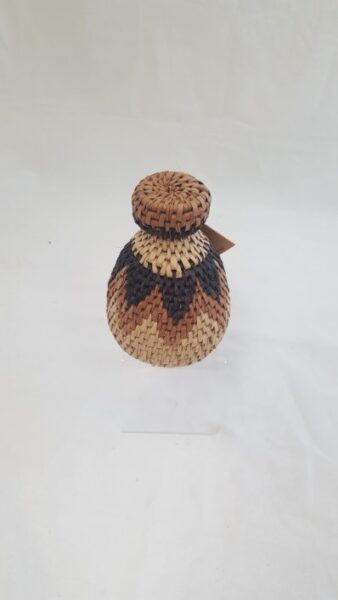
Zulu culture
20th century
Palm leaf, grasses, and pigment, L. 8 cm × W. 8 cm × H. 11.5 cm
BFPC collection #2013.31b
These two small herb baskets were finely woven of strong Ilala palm fibers, a material and technique that required the skillful use of a weaving awl. Traditionally, these baskets were used to hold spices or herbs for cooking as well as to hold medicinal herbs that were used in rituals. The designs on the basket are meaningful, as in Zulu culture, diamonds represent women, while triangles represent men. Researched by Lindsay Werner and Caitlin Baker
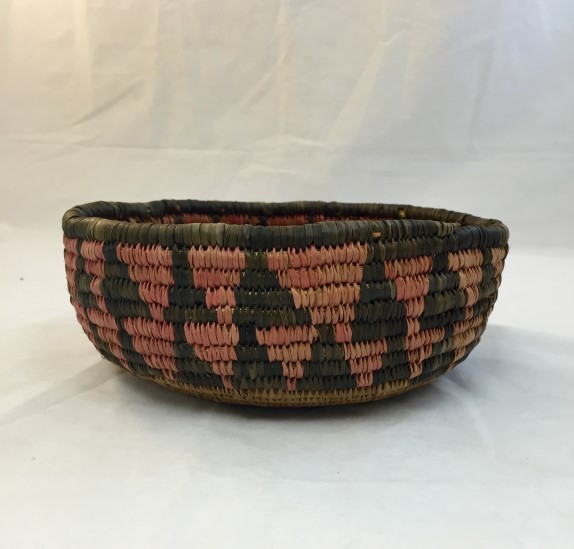
Zulu culture
20th century
Palm leaf, raffia, grasses, and pigment, L. 20.1 cm x W. 20.1 cm x H. 8 cm
BFPC collection #2010.19
This Zulu basket was tightly woven of raffia and palm leaf around a core of grasses, using a coil technique. The deep, rich pigments were created with traditional vegetable pigments, and the decorative triangle designs, which symbolize men in Zulu society, were added with strips of dyed palm leaf, worked into the fibers using a weaving awl. The inner surface of the basket would traditionally have been coated with ground corn paste to protect the fibers, and the basket would have held nuts or other coarse foodstuffs. As no residue of corn paste remains, this basket was most likely made for the tourist trade. Researched by Lindsay Werner
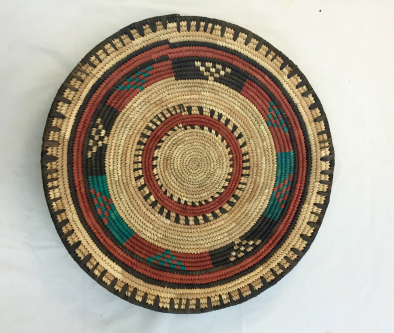
Hausa culture
20th century
Raffia, grasses, and pigment, L. 34.4 cm x W. 34.4 cm x H 4.7 cm
BFPC collection #2010.24
The Hausa people create flat, radial-patterned coiled baskets that are commonly given as gifts. These baskets serve as trays and also as lids for the tops of large calabash (gourd) vessels that hold grain or liquids; the baskets were made to fit snugly just inside the rim of a vessel, so that the lid would not be blown away by the wind. The geometric patterns on the basket, and in particular the triangle designs, were adopted by the Hausa from the Islamic Tuareg culture. In these cultures, triangles symbolize female fertility and they are believed to ward off evil. The tan, reddish-brown, and black tones of this basket are traditional, but the blue areas are unusual and suggest innovation by a Hausa weaver, or perhaps suggest that the basket was made to appeal to tourists. Researched by Lindsay Werner
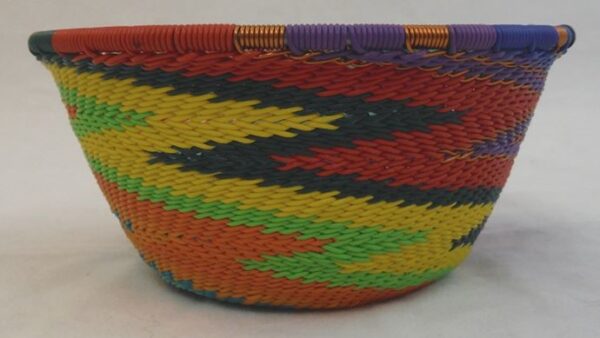
Late 20th century
Copper wire and plastic-coated copper wire
L. 12 cm x W. 12 cm x H. 5 cm
BFPC collection #2007.5
Basketry among the Zulu cultures is made by both men and women. The practice of weaving with wire was purportedly started by bored security guards in the 1930s, who used leftover wire from rock blasting along with traditional weaving techniques and designs to decorate their night sticks. The forms and designs of contemporary telephone wire baskets are based on traditional Zulu beer vessel covers, which were woven of palm fiber and grasses and have complex, zigzag designs.
The wire baskets start with a steel ring for a rim, and copper wire and plastic-coated telephone wire are wrapped around the ring with the wires stretching downward. The wires are then twisted together in a hook-stitch fashion. Great skill, practice, and hand strength are needed to pull the stitches tight and even, leaving no gaps. Telephone wire baskets have become very popular in the tourist trade; today, thanks to marketing, this form of basketry is a cottage industry that supplements income and supports the families of many rural Zulu artisans, who have few other employment opportunities. Researched by Randi Ryder
For more information, you may contact the researcher(s) noted in the title of this exhibit entry, or Dr. Billie Follensbee, the professor of the course, at BillieFollensbee@MissouriState.edu

